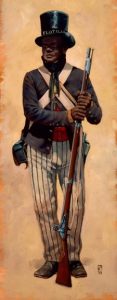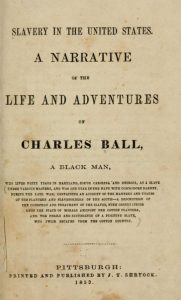Charles Ball
Charles Ball an enslaved person from Calvert County is known for documenting his life as a fugitive slave. But his valor during War of 1812 is depicted on the Battle of Bladensburg Monument.
Born around 1780 – unknown

Charles Ball ‘s story presents the reality of slave life. What was life like for a slave in Calvert County? For this we have the benefit of his autobiography titled, Fifty Years in Chains, or The Life of an American Slave or Slavery in the United States: written by a ex-slave, Charles Ball, and published in 1837. The book has several other names depending on when it was published. In the book, Bell often compares slavery in the South to that in Maryland.
Charles Ball (real name Charles Gross) grew up in Calvert County. He was sold to a slave owner in Georgia before the War of 1812. He escaped and made his way north to Calvert County, a journey that took a year. His constant objective was to return to his family. On his arrival in Calvert, he worked for farmers as a free man.
During the War of 1812, he enlisted with Joshua Barney, serving as a cook for the sailors who fought the British at St. Leonard Creek. He then fought with Barney’s men at Bladensburg and Baltimore. On his return to Calvert, he lived free for years until he was caught as a fugitive slave and sold again to a southern slave owner. Once again, he escaped, but this time he could not find his family. He lived out the rest of his life in Philadelphia, where he wrote his story. His descriptions include the following:
- Slaves were kept from running away by extreme intimidation.
- They lived in cabins – as many as 20 in a single small cabin — but often not as family units.
- They had little clothing. They might receive one set of clothes a year. They had rude shoes, if any. There was often no clothing for children no matter what the season.
- They received course food — typically cornbread and occasionally salt fish.
- There were good masters and bad masters, but it was the overseer who ruled by the whip, intimidation, and torture. Slave families were often separated, causing them great pain and anxiety. Fathers could make visits on Saturday night.
- Female slaves were valued more than males, as they would bear children who were slaves from birth, with the result that there were additional slaves every year or two. This was significant after the importation of slaves was banned in 1783.
- Sunday was a day off, but many slaves worked on Sunday to earn money.
- Slaves were often leased to others. Charles Ball, for example, was leased to the Navy Yard in Washington, DC, at age 20.
- Slave owners would not only buy slaves but also sell them to slave dealers, who would often take them south to sell them. Charles Ball walked from Calvert to South Carolina chained to 50 other slaves. The journey took four weeks, during which he constantly dreamed of escape – and considered suicide.
- After working a full day, slaves gardened to supplement their diet. They had little meat or fat to eat, and their rigorous work required additional nutrition. As is readily apparent, the treatment of slaves was inhumane to the extreme, and most certainly counter to our Christian principles.
Did you know?
Charles Ball is one of three sailors depicted on the Battle of Bladensburg Monument, at Bladensburg, Maryland.

Additional Resources
Trail of Souls Project Trail of Souls Project | Middleham and St. Peter’s Parish (middlehamandstpeters.org)
Jefferson Patterson Park exhibit on Charles Ball
Charles Ball and the Experience of Slavery, YouTube video Charles Ball & the Experience of Slavery (youtube.com)
Charles Ball was most known for his slave narrative, the 1837 book https://archive.org/stream/slaveryinunit00ballcha#page/n3/mode/2up The Life and Adventures of Charles Ball
